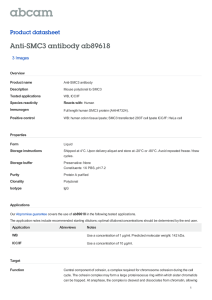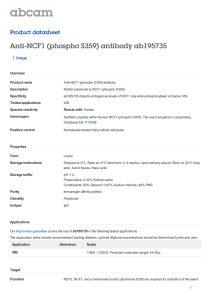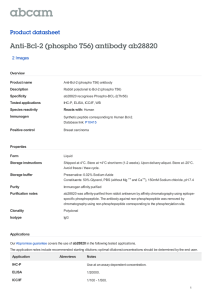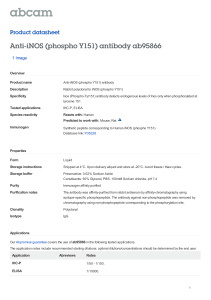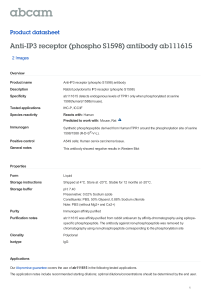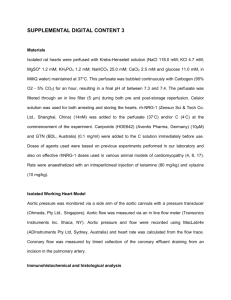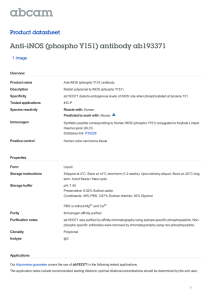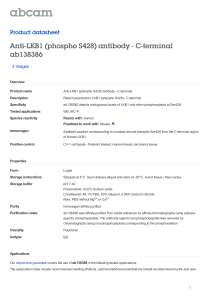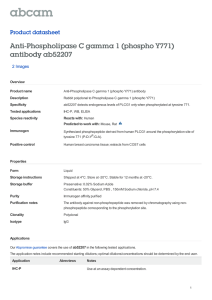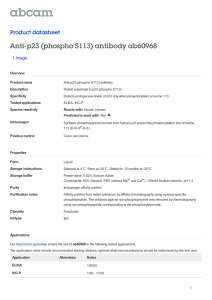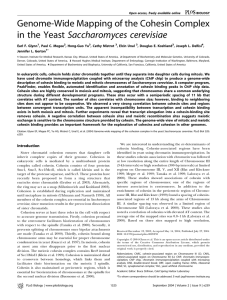Anti-SMC3 (phospho S1083) antibody ab83970 Product datasheet 2 Images
advertisement
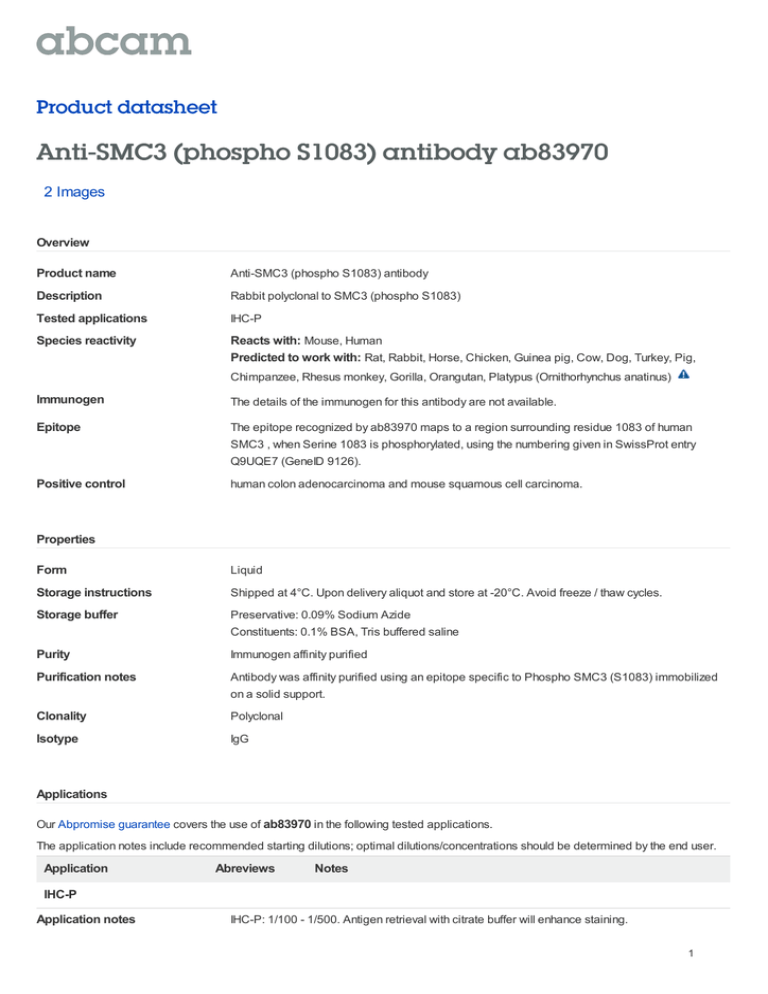
Product datasheet Anti-SMC3 (phospho S1083) antibody ab83970 2 Images Overview Product name Anti-SMC3 (phospho S1083) antibody Description Rabbit polyclonal to SMC3 (phospho S1083) Tested applications IHC-P Species reactivity Reacts with: Mouse, Human Predicted to work with: Rat, Rabbit, Horse, Chicken, Guinea pig, Cow, Dog, Turkey, Pig, Chimpanzee, Rhesus monkey, Gorilla, Orangutan, Platypus (Ornithorhynchus anatinus) Immunogen The details of the immunogen for this antibody are not available. Epitope The epitope recognized by ab83970 maps to a region surrounding residue 1083 of human SMC3 , when Serine 1083 is phosphorylated, using the numbering given in SwissProt entry Q9UQE7 (GeneID 9126). Positive control human colon adenocarcinoma and mouse squamous cell carcinoma. Properties Form Liquid Storage instructions Shipped at 4°C. Upon delivery aliquot and store at -20°C. Avoid freeze / thaw cycles. Storage buffer Preservative: 0.09% Sodium Azide Constituents: 0.1% BSA, Tris buffered saline Purity Immunogen affinity purified Purification notes Antibody was affinity purified using an epitope specific to Phospho SMC3 (S1083) immobilized on a solid support. Clonality Polyclonal Isotype IgG Applications Our Abpromise guarantee covers the use of ab83970 in the following tested applications. The application notes include recommended starting dilutions; optimal dilutions/concentrations should be determined by the end user. Application Abreviews Notes IHC-P Application notes IHC-P: 1/100 - 1/500. Antigen retrieval with citrate buffer will enhance staining. 1 Likely to work with frozen sections. Not yet tested in other applications. Optimal dilutions/concentrations should be determined by the end user. Target Function Central component of cohesin, a complex required for chromosome cohesion during the cell cycle. The cohesin complex may form a large proteinaceous ring within which sister chromatids can be trapped. At anaphase, the complex is cleaved and dissociates from chromatin, allowing sister chromatids to segregate. Cohesion is coupled to DNA replication and is involved in DNA repair. The cohesin complex plays also an important role in spindle pole assembly during mitosis and in chromosomes movement. Involvement in disease Defects in SMC3 are the cause of Cornelia de Lange syndrome type 3 (CDLS3) [MIM:610759]. CDLS is a dominantly inherited multisystem developmental disorder characterized by growth and cognitive retardation, abnormalities of the upper limbs, gastroesophageal dysfunction, cardiac, ophthalmologic and genitourinary anomalies, hirsutism, and characteristic facial features. CDSL3 is a mild form with absence of major structural anomalies typically associated with CDLS. The phenotype in some instances approaches that of apparently non-syndromic mental retardation. Sequence similarities Belongs to the SMC family. SMC3 subfamily. Domain The flexible hinge domain, which separates the large intramolecular coiled coil regions, allows the heterotypic interaction with the corresponding domain of SMC1A or SMC1B, forming a Vshaped heterodimer. The two heads of the heterodimer are then connected by different ends of the cleavable RAD21 protein, forming a ring structure. Post-translational modifications Phosphorylated upon DNA damage, probably by ATM or ATR. Acetylation at Lys-105 and Lys-106 by ESCO1 is important for genome stability and S phase sister chromatid cohesion. Regulated by DSCC1, it is required for processive DNA synthesis, coupling sister chromatid cohesion establishment during S phase to DNA replication. Cellular localization Nucleus. Chromosome. Chromosome > centromere. Associates with chromatin. Before prophase it is scattered along chromosome arms. During prophase, most of cohesin complexes dissociate from chromatin probably because of phosphorylation by PLK, except at centromeres, where cohesin complexes remain. At anaphase, the RAD21 subunit of the cohesin complex is cleaved, leading to the dissociation of the complex from chromosomes, allowing chromosome separation. Anti-SMC3 (phospho S1083) antibody images ab83970 at a 1/250 dilution, staining SMC3 (phospho 1083) in formaldehyde fixed, paraffin embedded human colon adenocarcinoma sections by Immunohistochemistry (Formalin/PFA-fixed immunohistochemistry. Left: Mock paraffin-embedded sections) - SMC3 (phospho phosphatase treated section. Right: calf S1083) antibody (ab83970) intestinal phosphatase-treated section. Detection by DAB staining. 2 ab83970 at a 1/250 dilution, staining SMC3 (phospho 1083) in formaldehyde fixed, paraffin embedded mouse squamous cell carcinoma sections by immunohistochemistry. Left: Mock phosphatase treated section. Right: calf intestinal phosphatase-treated section. Detection by DAB staining. Immunohistochemistry (Formalin/PFA-fixed paraffin-embedded sections) - SMC3 (phospho S1083) antibody (ab83970) Please note: All products are "FOR RESEARCH USE ONLY AND ARE NOT INTENDED FOR DIAGNOSTIC OR THERAPEUTIC USE" Our Abpromise to you: Quality guaranteed and expert technical support Replacement or refund for products not performing as stated on the datasheet Valid for 12 months from date of delivery Response to your inquiry within 24 hours We provide support in Chinese, English, French, German, Japanese and Spanish Extensive multi-media technical resources to help you We investigate all quality concerns to ensure our products perform to the highest standards If the product does not perform as described on this datasheet, we will offer a refund or replacement. For full details of the Abpromise, please visit http://www.abcam.com/abpromise or contact our technical team. Terms and conditions Guarantee only valid for products bought direct from Abcam or one of our authorized distributors 3
